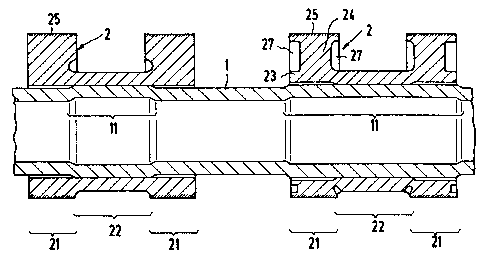Some of the information on this Web page has been provided by external sources. The Government of Canada is not responsible for the accuracy, reliability or currency of the information supplied by external sources. Users wishing to rely upon this information should consult directly with the source of the information. Content provided by external sources is not subject to official languages, privacy and accessibility requirements.
Any discrepancies in the text and image of the Claims and Abstract are due to differing posting times. Text of the Claims and Abstract are posted:
| (12) Patent: | (11) CA 1326962 |
|---|---|
| (21) Application Number: | 1326962 |
| (54) English Title: | DRIVESHAFT WITH DRIVING ELEMENTS ATTACHED TO IT IN GROUPS |
| (54) French Title: | ARBRE DE COMMANDE AUQUEL SONT FIXES DES ORGANES D'ENTRAINEMENT GROUPES |
| Status: | Expired and beyond the Period of Reversal |
| (51) International Patent Classification (IPC): |
|
|---|---|
| (72) Inventors : |
|
| (73) Owners : |
|
| (71) Applicants : |
|
| (74) Agent: | SMART & BIGGAR LP |
| (74) Associate agent: | |
| (45) Issued: | 1994-02-15 |
| (22) Filed Date: | 1988-10-03 |
| Availability of licence: | N/A |
| Dedicated to the Public: | N/A |
| (25) Language of filing: | English |
| Patent Cooperation Treaty (PCT): | No |
|---|
| (30) Application Priority Data: | ||||||
|---|---|---|---|---|---|---|
|
ABSTRACT
The force-locking connection between a shaft and
driving elements attached to it is improved or achieved
via a slight plastic expansion of the shaft in that the
driving elements are arranged in groups and connected by
connecting sleeves produced so as to be integral with the
driving elements. The higher degree of elastic expansion
is limited to the region of the connecting sleeves so that
the driving elements themselves are largely excluded from
this process. The dimensional accuracy of the finish-
machined driving elements is not adversely affected. If
necessary, recesses may be produced to form webs as a
result of which the elastic deformation occurring in the
inner region is reduced.
Note: Claims are shown in the official language in which they were submitted.
Note: Descriptions are shown in the official language in which they were submitted.

2024-08-01:As part of the Next Generation Patents (NGP) transition, the Canadian Patents Database (CPD) now contains a more detailed Event History, which replicates the Event Log of our new back-office solution.
Please note that "Inactive:" events refers to events no longer in use in our new back-office solution.
For a clearer understanding of the status of the application/patent presented on this page, the site Disclaimer , as well as the definitions for Patent , Event History , Maintenance Fee and Payment History should be consulted.
| Description | Date |
|---|---|
| Time Limit for Reversal Expired | 2010-02-15 |
| Letter Sent | 2009-02-16 |
| Inactive: IPC from MCD | 2006-03-11 |
| Inactive: IPC from MCD | 2006-03-11 |
| Inactive: Late MF processed | 2002-03-20 |
| Letter Sent | 2002-02-15 |
| Grant by Issuance | 1994-02-15 |
There is no abandonment history.
| Fee Type | Anniversary Year | Due Date | Paid Date |
|---|---|---|---|
| MF (category 1, 4th anniv.) - standard | 1998-02-16 | 1998-01-23 | |
| MF (category 1, 5th anniv.) - standard | 1999-02-15 | 1999-01-21 | |
| MF (category 1, 6th anniv.) - standard | 2000-02-15 | 2000-01-14 | |
| MF (category 1, 7th anniv.) - standard | 2001-02-15 | 2001-01-15 | |
| Reversal of deemed expiry | 2002-02-15 | 2002-03-20 | |
| MF (category 1, 8th anniv.) - standard | 2002-02-15 | 2002-03-20 | |
| MF (category 1, 9th anniv.) - standard | 2003-02-17 | 2003-01-21 | |
| MF (category 1, 10th anniv.) - standard | 2004-02-16 | 2004-01-19 | |
| MF (category 1, 11th anniv.) - standard | 2005-02-15 | 2005-01-18 | |
| MF (category 1, 12th anniv.) - standard | 2006-02-15 | 2006-01-24 | |
| MF (category 1, 13th anniv.) - standard | 2007-02-15 | 2007-01-23 | |
| MF (category 1, 14th anniv.) - standard | 2008-02-15 | 2008-01-23 |
Note: Records showing the ownership history in alphabetical order.
| Current Owners on Record |
|---|
| EMITEC GESELLSCHAFT FUR EMISSIONSTECHNOLOGIE MBH |
| Past Owners on Record |
|---|
| HELMUT SWARS |